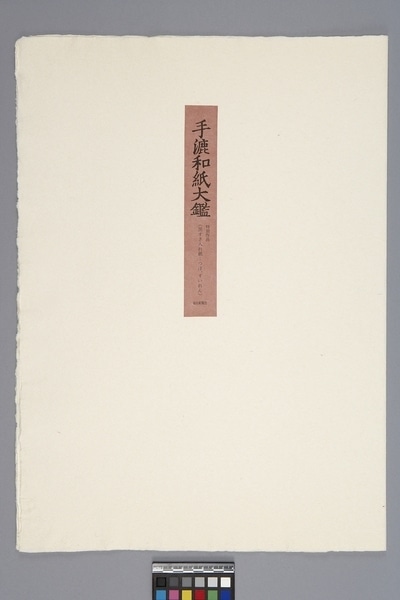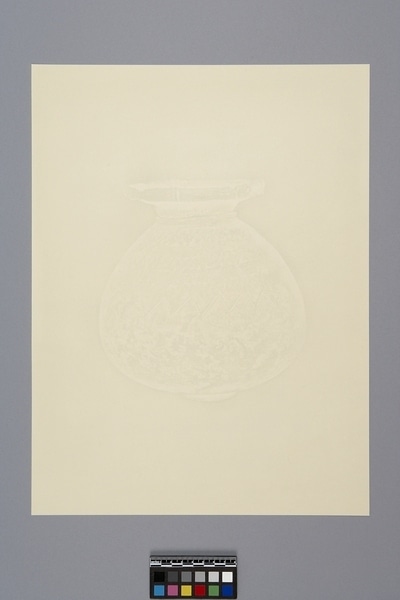Paper Item Number: Ed5.1743 a-d from the MOA: University of British Columbia




Description
Part (a) is a yellow-white paper folder. Part (b) is a white cardboard folder. Part (c) is green paper with designs. Part (d) is tan paper with designs.
Part (a) is a thick, heavy roughened yellow white paper, folded, flap opening from left, all edges retain an irregular deckle edge. Brown rectangular strip on front has black Japanese script. Part (b) is a thick cardboard folder with Japanese and English writing inside the front cover. Part (c) is green sample paper with design of two flowers with many petals, various-sized round lilies in a pond, and a double pine cone piece lying on one lily. Design only revealed when sheet is held up to light. Part (d) is tan sample paper with central design of jar, quickly swelling from small circular base and tapering to short widely flared mouth. Around circumference, zigzag line at shoulder; other bands of lines and geometric motifs above. Clarity striking only when sheet is held up to light.
History Of Use
Papermaking originated on the Asian mainland and spread to Japan by 1500 years ago. For centuries Japan has produced the greatest quantity and variety of handmade paper or washi in the world. Traditionally, papermaking was a family or community enterprise which thrived in mountain farming communities where cold, pure water and wild bast fibre shrubs, such as mulberry, are plentiful. Washi is an important cultural symbol and holds a place in nearly every aspect of Japanese life. It is also a significant aspect of both Shinto and Buddhist rites and customs. 'Kurosuki' or shade watermark first developed by Printing Bureau, Ministry of Finance in 1889 for bank notes and other official documents. Prevents counterfeiting.
Cultural Context
samples
Narrative
This is part of the Tesukiwashi Taikan, a collection of handmade paper published, in an edition of 1000 copies, in Tokyo as a project to commemorate the centennial of Mainchi Newspapers and to preserve Japanese handmade paper. A collection on this scale had not been made before. This collection consists of 5 boxes of mounted and labelled samples with an explanatory book in 4 of the boxes. The text is in Japanese and with less detail, in English. Compiled and edited by a special editorial staff of scholars. Published by the Mainchi Newspapers of Tokyo, Japan.
Item History
- Made by Seishiro Suzuki (Maker) and Yayoji Shiomi (Maker) in Tokyo, Japan before 1974
- Collected during 1977
- Owned by Yoshihisa Okamatsu before March 23, 1977
- Received from Yoshihisa Okamatsu (Donor) on March 23, 1977
What
- Name
- Paper
- Identification Number
- Ed5.1743 a-d
- Type of Item
- paper
- Overall
- height 51.0 cm, width 36.7 cm
Who
- Culture
- Japanese
- Creator
- Seishiro Suzuki (Maker) and Yayoji Shiomi (Maker)
- Previous Owner
- Yoshihisa Okamatsu
- Received from
- Yoshihisa Okamatsu (Donor)
Where
- Holding Institution
- MOA: University of British Columbia
- Made in
- Tokyo, Japan
When
- Creation Date
- before 1974
- Collection Date
- during 1977
- Ownership Date
- before March 23, 1977
- Acquisition Date
- on March 23, 1977
Other
- Item Classes
- works on paper
- Condition
- good
- Accession Number
- 0369/0015 a-c